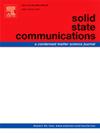Tuning band gap and improving optoelectronic properties of lead-free halide perovskites FrMI3 (M = Ge, Sn) under hydrostatic pressure
IF 2.1
4区 物理与天体物理
Q3 PHYSICS, CONDENSED MATTER
引用次数: 0
Abstract
In the field of optoelectronic applications, inorganic cubic halide perovskites have turned into a leading choice for commercialization. The physical properties of cubic FrMI3 (M = Ge, Sn) halide perovskites under pressure are explored at multiple pressures up to 10 GPa using ab initio Density-Functional Theory due to their significant importance. The structural accuracy, reflected in lattice parameters and unit cell volume, closely corresponds to previously reported data. FrGeI3 and FrSnI3 exhibited direct electronic band gaps of 0.65 eV and 0.46 eV with GGA-PBE functional, respectively, indicating their semiconducting nature at 0 GPa. The enhanced band gaps obtained employing the HSE06 potential are 1.61 eV and 1.28 eV for the corresponding perovskites. FrGeI3 and FrSnI3 shift from semiconducting to metallic states under pressures of 4.5 GPa and 3 GPa, respectively, thereby enhancing the conductivity. Pressure also improves optical functions, indicating both perovskites may be employed in high-efficiency optoelectronic devices that operate within the visible and ultra-violet (UV) range. At 10 GPa pressure, both FrGeI3 and FrSnI3 demonstrate the sharpest absorption spikes in the UV region, approximately at 2.61 × 105 cm−1 and 2.42 × 105 cm−1, respectively, resulting in sharp peaks in optical conductivity of approximately 5.98 1/fs for FrGeI3 and 5.49 1/fs for FrSnI3. FrGeI3 consistently outperforms FrSnI3, offering superior electronic and optical characteristics. Additionally, pressure modifies the mechanical features of entitled perovskites while conserving stability. The anisotropic and ductile properties become more pronounced under pressure. The outcomes of this study are expected to propel the advancement of lead-free optoelectronic devices, driving innovation in sustainable energy solutions.
在静水压力下调整无铅卤化物包晶 FrMI3(M = Ge、Sn)的带隙并改善其光电特性
在光电应用领域,无机立方卤化物包晶已成为商业化的主要选择。由于立方FrMI3(M = Ge、Sn)卤化物包晶石的重要性,本研究采用ab initio 密度-函数理论在高达 10 GPa 的多个压力下对其物理性质进行了探索。反映在晶格参数和单胞体积上的结构精度与之前报告的数据非常吻合。利用 GGA-PBE 函数,FrGeI3 和 FrSnI3 的直接电子带隙分别为 0.65 eV 和 0.46 eV,这表明它们在 0 GPa 时具有半导体性质。利用 HSE06 电位得到的相应过氧化物的增强带隙分别为 1.61 eV 和 1.28 eV。FrGeI3 和 FrSnI3 分别在 4.5 GPa 和 3 GPa 的压力下从半导体态转变为金属态,从而提高了导电性。压力还能改善光学功能,这表明这两种包晶均可用于在可见光和紫外线(UV)范围内工作的高效光电设备。在 10 GPa 压力下,FrGeI3 和 FrSnI3 在紫外区都表现出最尖锐的吸收峰值,分别约为 2.61 × 105 cm-1 和 2.42 × 105 cm-1,从而使 FrGeI3 和 FrSnI3 的光导率分别达到约 5.98 1/fs 和 5.49 1/fs 的尖锐峰值。FrGeI3 的电子和光学特性始终优于 FrSnI3。此外,压力在保持稳定的同时,也改变了有权利的过氧化物晶石的机械特性。各向异性和延展性在压力作用下变得更加明显。这项研究的成果有望推动无铅光电设备的发展,推动可持续能源解决方案的创新。
本文章由计算机程序翻译,如有差异,请以英文原文为准。
求助全文
约1分钟内获得全文
求助全文
来源期刊

Solid State Communications
物理-物理:凝聚态物理
CiteScore
3.40
自引率
4.80%
发文量
287
审稿时长
51 days
期刊介绍:
Solid State Communications is an international medium for the publication of short communications and original research articles on significant developments in condensed matter science, giving scientists immediate access to important, recently completed work. The journal publishes original experimental and theoretical research on the physical and chemical properties of solids and other condensed systems and also on their preparation. The submission of manuscripts reporting research on the basic physics of materials science and devices, as well as of state-of-the-art microstructures and nanostructures, is encouraged.
A coherent quantitative treatment emphasizing new physics is expected rather than a simple accumulation of experimental data. Consistent with these aims, the short communications should be kept concise and short, usually not longer than six printed pages. The number of figures and tables should also be kept to a minimum. Solid State Communications now also welcomes original research articles without length restrictions.
The Fast-Track section of Solid State Communications is the venue for very rapid publication of short communications on significant developments in condensed matter science. The goal is to offer the broad condensed matter community quick and immediate access to publish recently completed papers in research areas that are rapidly evolving and in which there are developments with great potential impact.
 求助内容:
求助内容: 应助结果提醒方式:
应助结果提醒方式:


